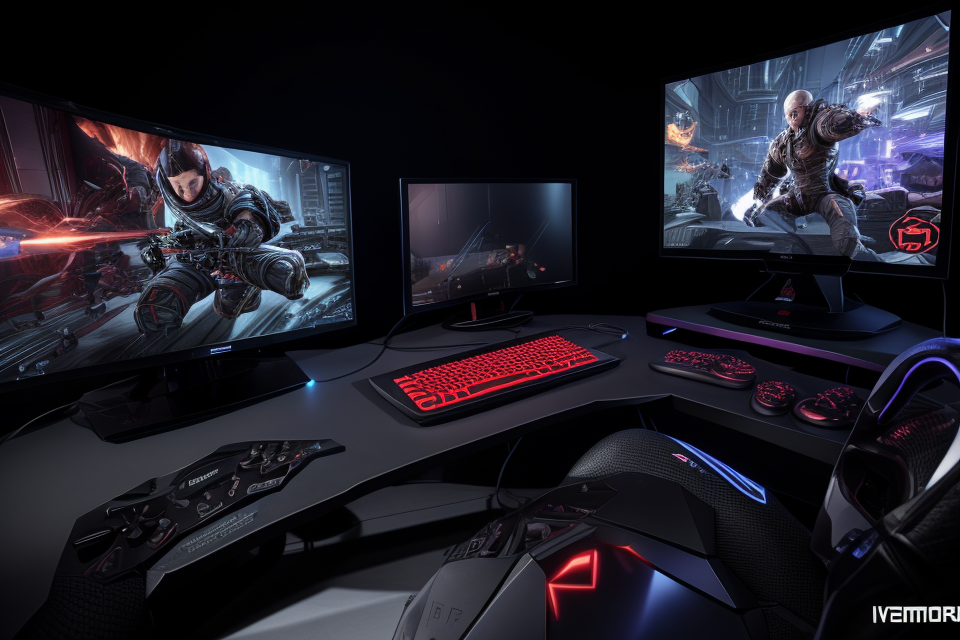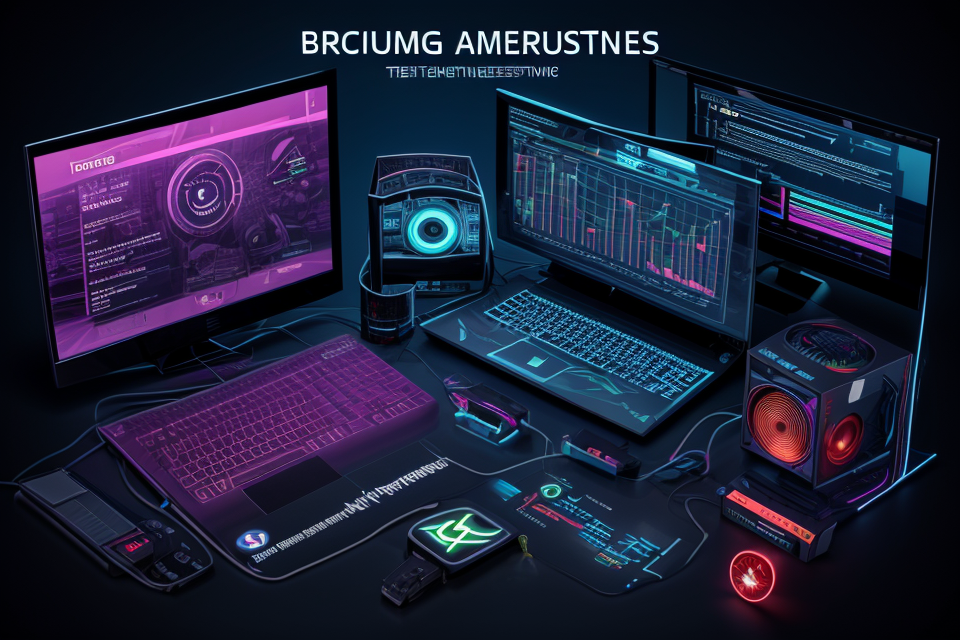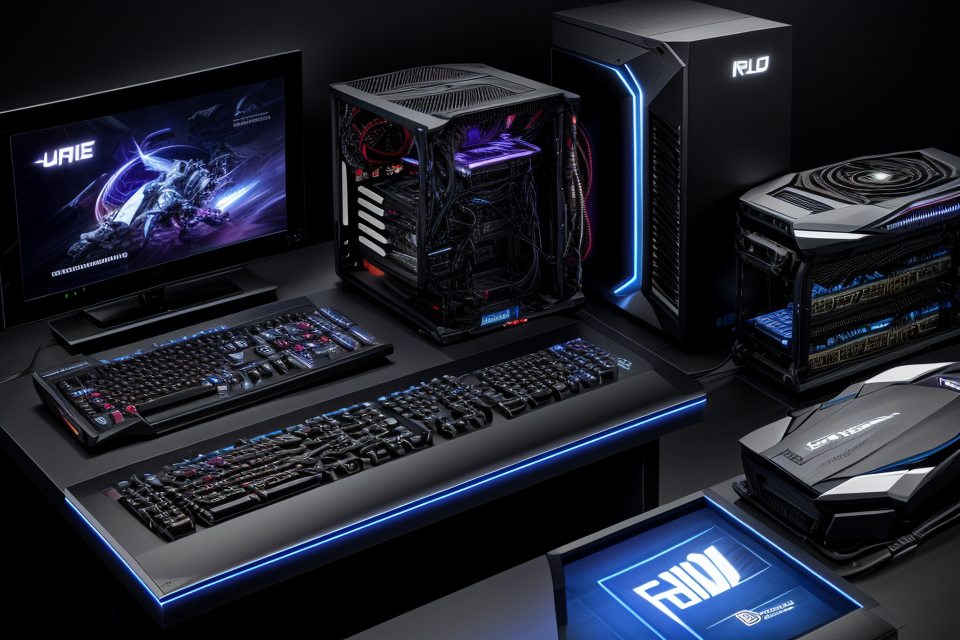
Gamers are always on the lookout for ways to improve their gaming experience. One of the most critical components in achieving smooth and seamless gameplay is the graphics processing unit (GPU). But with so many GPUs on the market, which specs really matter for gaming performance? In this article, we’ll dive into the key features that affect gaming performance and help you make an informed decision when choosing your next GPU. So, gear up and let’s explore the world of GPUs!
The GPU (Graphics Processing Unit) is a critical component for gaming performance, and there are several factors to consider when choosing a GPU. The most important specs to consider are the number of CUDA cores, memory size, and memory bandwidth. The number of CUDA cores determines the GPU’s processing power, with more cores providing better performance. Memory size and bandwidth determine how quickly the GPU can access and process data, with more memory and higher bandwidth providing smoother gameplay and higher frame rates. Additionally, the type of GPU (such as NVIDIA or AMD) and its compatibility with the game’s engine can also impact performance. Ultimately, the best GPU for gaming performance will depend on the specific games and settings you plan to use, as well as your budget.
Understanding GPU Performance for Gaming
What is a GPU?
A Graphics Processing Unit (GPU) is a key component in a computer that is responsible for rendering images and graphics. It is designed to quickly process large amounts of data and perform complex calculations to create high-quality visuals. The GPU is specifically designed to handle the demands of gaming, which requires fast and efficient rendering of graphics and animations.
GPUs come in a variety of shapes and sizes, and the specifications of a GPU can have a significant impact on its performance. Understanding the key components of a GPU and how they work together can help you make informed decisions when selecting a GPU for gaming.
Some of the most important specifications to consider when selecting a GPU for gaming include the number of cores, clock speed, memory size, and memory bandwidth. These specifications can have a direct impact on the performance of the GPU and its ability to handle demanding gaming workloads.
By understanding the role of a GPU in gaming and the specifications that matter most, you can make informed decisions when selecting a GPU and optimize your gaming experience.
How does a GPU impact gaming performance?
A Graphics Processing Unit (GPU) plays a crucial role in determining the gaming performance of a computer. The GPU is responsible for rendering the visuals and handling complex calculations that are required for realistic and smooth gameplay.
Here are some key ways in which a GPU impacts gaming performance:
- Handles complex calculations and rendering of graphics: The GPU is specifically designed to handle the intensive calculations required for rendering graphics in real-time. This includes tasks such as transforming and lighting objects, applying textures, and rendering special effects. The GPU can perform these calculations much faster than the CPU, which allows for smoother gameplay and higher frame rates.
- Enables smoother gameplay and higher frame rates: The GPU is responsible for rendering the visuals in real-time, which means it needs to be able to keep up with the demands of the game. If the GPU is not powerful enough, the game may experience slowdowns or stuttering, which can negatively impact the overall gaming experience. A more powerful GPU can handle higher resolutions, more complex graphics, and higher frame rates, resulting in smoother gameplay and a more immersive experience.
- Supports advanced features and technologies: Many modern games require advanced features and technologies, such as ray tracing, advanced lighting effects, and physics simulations, which can be very demanding on the GPU. A more powerful GPU can handle these features and technologies, allowing for a more realistic and immersive gaming experience.
Overall, the GPU is a critical component in determining the gaming performance of a computer. A more powerful GPU can handle the demands of modern games, resulting in smoother gameplay, higher frame rates, and a more immersive experience.
Key GPU Specs for Gaming Performance
1. CUDA Cores
What are CUDA Cores?
CUDA cores are specialized processing units that are designed to accelerate the performance of NVIDIA GPUs in various applications, including gaming. These cores are designed to handle complex mathematical calculations that are commonly found in games, such as rendering graphics, physics simulations, and artificial intelligence algorithms.
How do they impact gaming performance?
CUDA cores play a crucial role in determining the overall gaming performance of a GPU. The more CUDA cores a GPU has, the more parallel threads it can process simultaneously, which leads to faster frame rates and smoother gameplay. Additionally, CUDA cores also help to improve the overall efficiency of the GPU, which means that it can perform more tasks in a shorter amount of time.
Importance of CUDA Core count for gaming
The number of CUDA cores is one of the most important factors to consider when choosing a GPU for gaming. In general, the more CUDA cores a GPU has, the better it will perform in games that require intense graphical processing. However, it’s important to note that the number of CUDA cores is just one factor to consider when choosing a GPU for gaming. Other factors, such as memory size, memory bandwidth, and cooling solution, also play a crucial role in determining the overall gaming performance of a GPU.
2. VRAM
What is VRAM?
Virtual Memory Address Map, commonly referred to as VRAM, is a type of memory found on a graphics card. It serves as a buffer between the CPU and the graphics card, allowing the GPU to render images and videos more efficiently.
How does VRAM impact gaming performance?
VRAM plays a crucial role in determining the gaming performance of a graphics card. It acts as a storage space for the textures, shaders, and other graphical elements required for rendering games. The more VRAM a graphics card has, the more detailed and complex graphics it can handle without sacrificing performance.
When a game is rendered, the GPU retrieves the necessary data from the VRAM, which helps to improve the frame rate and overall performance of the game. With insufficient VRAM, the GPU may need to access the system memory, which can significantly slow down the performance, leading to stuttering, lagging, or even crashes.
Importance of VRAM for gaming
The importance of VRAM in gaming cannot be overstated. As games become more complex and detailed, the demand for VRAM increases. High-end games with advanced graphics, such as first-person shooters, racing games, and open-world games, require a substantial amount of VRAM to render the intricate details and textures.
Moreover, VRAM also plays a critical role in preventing screen tearing and other visual artifacts that can negatively impact the gaming experience. With enough VRAM, the GPU can render the game at a higher resolution, resulting in a smoother and more immersive gaming experience.
In conclusion, VRAM is a critical component of a graphics card, and its importance cannot be overlooked when considering gaming performance. The amount of VRAM required for gaming depends on the specific game and its requirements, but generally, a graphics card with at least 4GB of VRAM is recommended for optimal gaming performance.
3. Memory Bandwidth
What is memory bandwidth?
Memory bandwidth refers to the rate at which data can be transferred between the GPU’s memory and the rest of the system. It is typically measured in megabytes per second (MB/s) or gigabytes per second (GB/s).
How does it impact gaming performance?
Memory bandwidth plays a crucial role in gaming performance because it determines how quickly the GPU can access and process the data needed to render images on the screen. A higher memory bandwidth means that the GPU can load and process textures, models, and other game assets faster, resulting in smoother frame rates and reduced input lag.
Importance of memory bandwidth for gaming
Memory bandwidth is especially important for fast-paced games that require the GPU to quickly access and process large amounts of data. In first-person shooters, for example, a high memory bandwidth can make a significant difference in the smoothness of the frame rates and the responsiveness of the controls.
In addition, some games have large open worlds or detailed environments that require a lot of data to be loaded and processed in real-time. A high memory bandwidth can help the GPU keep up with these demands, resulting in a more immersive and seamless gaming experience.
Overall, memory bandwidth is a critical factor in gaming performance, and it is important to consider when choosing a GPU for gaming.
4. Texture Fill Rate
What is texture fill rate?
Texture fill rate refers to the speed at which a GPU can process and render textures in a frame. It is measured in millions of texels per second (MT/s) and is an important metric for gaming performance. Texels are the smallest unit of texture data that a GPU can process, and texture fill rate measures how many texels the GPU can process in a second.
How does it impact gaming performance?
Texture fill rate plays a crucial role in gaming performance, particularly in games that rely heavily on textures. In these games, the GPU needs to quickly render and update textures to create realistic and detailed graphics. If the texture fill rate is too low, the GPU may not be able to keep up with the demands of the game, resulting in slow frame rates and laggy performance.
Importance of texture fill rate for gaming
Texture fill rate is especially important for gaming on high-resolution displays, such as 4K or 8K monitors. These displays require more textures to be rendered in each frame, which puts a greater strain on the GPU. As a result, a higher texture fill rate is necessary to maintain smooth and consistent frame rates. Additionally, texture fill rate can also impact the overall visual quality of the game, as it affects the clarity and detail of textures. A higher texture fill rate can result in more vibrant and realistic graphics, enhancing the overall gaming experience.
5. Thermal Performance
Thermal performance refers to the ability of a GPU to dissipate heat efficiently and maintain optimal operating temperatures during intense gaming sessions. This aspect is crucial for ensuring consistent and reliable performance without throttling or shutting down due to overheating.
- Impact on Gaming Performance
When a GPU’s temperature exceeds safe limits, it may throttle its clock speed to prevent damage, resulting in reduced gaming performance. Higher temperatures can also lead to reduced lifespan and increased failure rates, affecting the long-term stability and reliability of the GPU.
- Importance of Thermal Performance for Gaming
Thermal performance is a critical factor in gaming as it directly affects the GPU’s ability to maintain high clock speeds and sustain peak performance levels. A well-designed cooling solution ensures that the GPU operates within safe temperature ranges, allowing it to deliver consistent frame rates and minimize performance fluctuations during gaming sessions.
Moreover, a GPU with efficient cooling can operate at higher power levels, resulting in better performance compared to a similarly configured GPU with poor thermal characteristics. This can translate to smoother gameplay, reduced input lag, and lower stuttering or frame drops, ultimately enhancing the overall gaming experience.
Therefore, when evaluating GPUs for gaming performance, it is essential to consider their thermal characteristics, such as cooling solutions, fan design, and thermal throttling thresholds, to ensure consistent and reliable performance in various gaming scenarios.
6. Power Consumption
Power consumption refers to the amount of energy required by the graphics processing unit (GPU) to function. It is measured in watts (W) and indicates the amount of power the GPU draws from the power supply unit (PSU) to perform tasks. Power consumption is a critical aspect of gaming performance, as it directly affects the overall energy efficiency and heat output of the GPU.
- Impact on Gaming Performance:
Power consumption has a direct impact on the performance of the GPU. The higher the power consumption, the more energy the GPU requires to perform tasks, which can lead to higher temperatures and reduced lifespan of the GPU. On the other hand, a GPU with lower power consumption will consume less energy, resulting in lower temperatures and a longer lifespan. This is crucial for gaming performance, as a GPU with higher power consumption may struggle to maintain high frame rates during prolonged gaming sessions, leading to thermal throttling and a decrease in performance. - Importance of Power Consumption for Gaming:
Power consumption is an essential factor to consider when choosing a GPU for gaming. It is important to select a GPU with a power consumption that matches the power supply unit (PSU) in the computer system. A GPU with a higher power consumption than the PSU can result in instability and potential damage to the GPU or other components in the system. Conversely, a GPU with lower power consumption may not be able to provide sufficient performance to meet the demands of modern games. Therefore, it is essential to choose a GPU with the right power consumption to ensure optimal gaming performance and longevity.
Factors Affecting GPU Performance for Gaming
1. Game Title
The first and most crucial factor that affects the GPU performance for gaming is the game title itself. Different games have varying requirements for the GPU, and these requirements can significantly impact the gaming experience. Some games may require more VRAM, while others may require more CUDA cores. It is essential to understand the specific requirements of the game you are playing to ensure that your GPU meets the minimum specifications.
When it comes to VRAM, some games require more memory to store textures, models, and other graphics assets. For example, first-person shooters may require more VRAM than strategy games. Therefore, it is important to consider the VRAM requirements of the game you are playing when selecting a GPU.
CUDA cores, on the other hand, are responsible for parallel processing and are crucial for gaming performance. Some games may require more CUDA cores to run smoothly, while others may not. Therefore, it is important to consider the CUDA core requirements of the game you are playing when selecting a GPU.
In summary, the game title is the most critical factor that affects the GPU performance for gaming. Understanding the specific requirements of the game you are playing can help you select the right GPU to ensure a smooth and enjoyable gaming experience.
2. Resolution
- Higher resolutions require more GPU power
- Impacts frame rates and overall gaming performance
Resolution is a critical factor that affects the gaming performance of a GPU. The higher the resolution, the more GPU power is required to render the images on the screen. This means that as the resolution increases, the frame rates and overall gaming performance will also be affected.
When it comes to gaming, the most common resolutions are 1080p, 1440p, and 4K. A 1080p resolution has a pixel count of 1920 x 1080, while a 1440p resolution has a pixel count of 2560 x 1440, and a 4K resolution has a pixel count of 3840 x 2160. As the pixel count increases, so does the amount of data that needs to be processed by the GPU, which in turn requires more powerful hardware.
In addition to the pixel count, the refresh rate of the monitor also plays a role in determining the GPU requirements for gaming. A higher refresh rate means that the monitor is capable of displaying more frames per second, which can impact the required GPU performance. For example, a monitor with a refresh rate of 60Hz will require more GPU power than a monitor with a refresh rate of 30Hz.
Overall, the resolution of the monitor is a crucial factor that affects the gaming performance of a GPU. Higher resolutions require more GPU power, and as such, it is essential to consider the resolution of the monitor when selecting a GPU for gaming purposes.
3. Frame Rate
- Importance of frame rate for smooth gameplay
- Frame rate, also known as FPS (Frames Per Second), is the number of times an image is refreshed on the screen per second.
- A higher frame rate provides a smoother and more responsive gaming experience.
- This is because there are more images being displayed per second, making the motion appear more fluid and reducing the likelihood of motion blur or ghosting.
- Higher frame rates require more GPU power
- In order to achieve higher frame rates, the GPU must be able to render more images per second.
- This requires more processing power, which is why a more powerful GPU is necessary to achieve higher frame rates.
- The relationship between frame rate and GPU power is not linear, meaning that a significant increase in GPU power may not result in a proportional increase in frame rate.
- Other factors, such as the capabilities of the game engine and the hardware of the game console or computer, also play a role in determining the maximum achievable frame rate.
4. Graphics Quality
When it comes to gaming performance, graphics quality plays a crucial role in determining the overall experience. Higher graphics quality typically requires more GPU power, which directly impacts frame rates and overall gaming performance. Here are some key factors to consider when it comes to graphics quality and its impact on gaming performance:
Resolution
The resolution of a game refers to the number of pixels on the screen. A higher resolution typically results in sharper and more detailed images, but it also requires more GPU power to render those images. For example, a game running at 1080p resolution will require more GPU power than the same game running at 720p resolution.
Frame Rate
Frame rate refers to the number of frames rendered per second. A higher frame rate results in smoother and more fluid motion, but it also requires more GPU power to render those frames. In general, a higher frame rate is desirable for a better gaming experience, but it may require a more powerful GPU to achieve.
Textures and Effects
The level of detail in textures and effects can also impact gaming performance. Higher quality textures and effects require more GPU power to render, which can impact frame rates and overall performance. However, these effects can also enhance the overall gaming experience by providing a more immersive and realistic environment.
Antialiasing and Supersampling
Antialiasing and supersampling are techniques used to improve the visual quality of games by reducing aliasing and increasing the accuracy of color and texture reproduction. These techniques can enhance the overall visual quality of a game, but they also require more GPU power to render, which can impact frame rates and overall performance.
In summary, graphics quality is a critical factor in determining gaming performance. Higher resolutions, frame rates, textures, and effects all require more GPU power to render, which can impact overall performance. However, these factors can also enhance the overall gaming experience by providing a more immersive and visually stunning environment.
FAQs
1. What is a GPU and why is it important for gaming?
A GPU, or Graphics Processing Unit, is a specialized type of processor designed specifically for handling the complex mathematical calculations required to render images and video. In gaming, a powerful GPU is essential for rendering high-quality graphics and smooth gameplay.
2. What are some key specifications to look for in a gaming GPU?
Some key specifications to look for in a gaming GPU include the number of CUDA cores, memory size, memory bandwidth, and clock speed. The more CUDA cores a GPU has, the better it is at handling complex calculations. Memory size and bandwidth determine how much data the GPU can process at once, while clock speed determines how quickly it can process that data.
3. What is the difference between integrated and dedicated GPUs?
Integrated GPUs are built into the CPU and are typically less powerful than dedicated GPUs, which are standalone chips designed specifically for handling graphics processing. Dedicated GPUs are generally recommended for gaming, as they offer better performance and more advanced features.
4. How do I know if my current GPU is sufficient for gaming?
To determine if your current GPU is sufficient for gaming, you can check its specifications and compare them to the minimum and recommended requirements for the games you want to play. You can also run benchmark tests to see how well your GPU performs in real-world gaming scenarios.
5. How do I choose the right GPU for my budget and gaming needs?
To choose the right GPU for your budget and gaming needs, you should consider your current and future gaming requirements, as well as your budget. Research different GPU models and compare their specifications and performance to find the one that best meets your needs. You may also want to consider factors such as power consumption and noise level.


